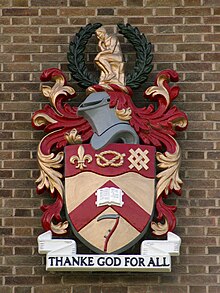University College of North Staffordshire

Keele University coat of arms
|
|
| Motto | Thanke God for All |
|---|---|
| Type | Public |
| Established | 1949 (as University College of North Staffordshire) 1962 Royal Charter granted for university status |
| Endowment | £0.95 million (2015) |
| Chancellor | Jonathon Porritt CBE |
| Vice-Chancellor | Trevor McMillan |
| Visitor | The Lord President of the Council ex officio |
|
Academic staff
|
860 |
|
Administrative staff
|
875 |
| Students | 10,120 (2015/16) |
| Undergraduates | 7,915 (2015/16) |
| Postgraduates | 2,205 (2015/16) |
| Location |
Keele, Newcastle-under-Lyme, Staffordshire, United Kingdom 53°00′11″N 2°16′23″W / 53.003°N 2.273°WCoordinates: 53°00′11″N 2°16′23″W / 53.003°N 2.273°W |
| Campus | Rural |
| Colours | |
| Mascot | Herbert the Dragon |
| Affiliations |
ACU EUA UUK UWM |
| Website | www |
 |
|
|
QS (2016/17, national) |
53 | |
|---|---|---|
|
QS (2016/17, world) |
551–600 | |
|
THE (2016/17, national) |
53 | |
|
THE (2016/17, world) |
401–500 | |
|
Complete (2018, national) |
46 | |
|
The Guardian (2017, national) |
34 | |
|
Times/Sunday Times (2017, national) |
42 | |
Keele University, officially known as the University of Keele, is a public research university located about 3 miles (5 km) from Newcastle-under-Lyme, Staffordshire, England. Keele was granted university status by Royal Charter in 1962 and was founded in 1949 as the University College of North Staffordshire. Keele is the 24th oldest university in the UK List of UK universities by date of foundation, and highest research-ranked university in Staffordshire. A science park and a conference centre complements the academic buildings, making it the largest campus university in the UK. The university's School of Medicine operates the clinical part of its courses from a separate campus at the Royal Stoke University Hospital with the School of Nursing and Midwifery is based at the nearby Clinical Education Centre.
The university occupies a 620-acre (250 ha) rural campus close to the village of Keele and consists of extensive woods, lakes and Keele Hall set in historic Staffordshire Potteries heartland. The estate was originally given by King Henry II of England to the Knights Templars, AD 1180. When the Templars were condemned and dissolved by the Council of Vienne in the time of Pope Clement V AD 1311, their possessions were annexed by the Knights Hospitallers until their dissolution by Henry VIII. The estate was purchased from the Crown by the Sneyd family and remained in their property until acquisition by the Stoke-on-Trent Corporation in 1948.0
...
Wikipedia
